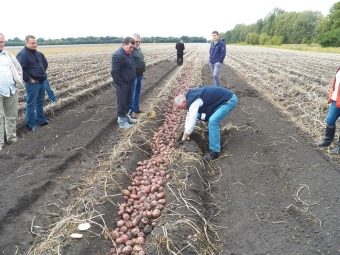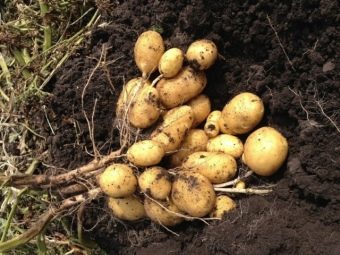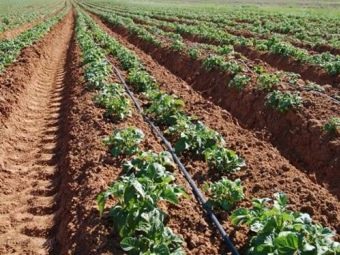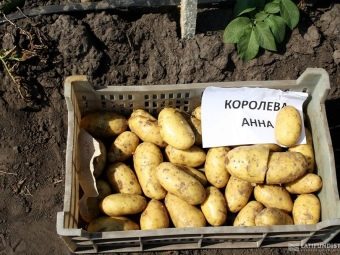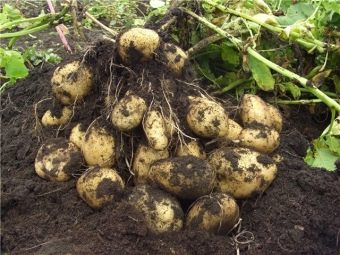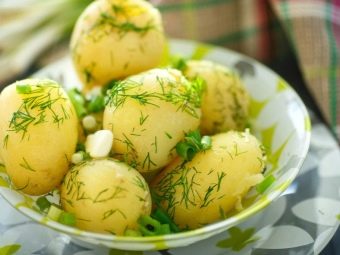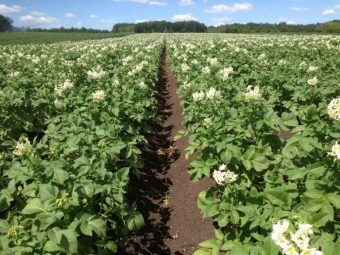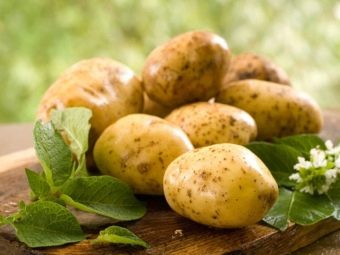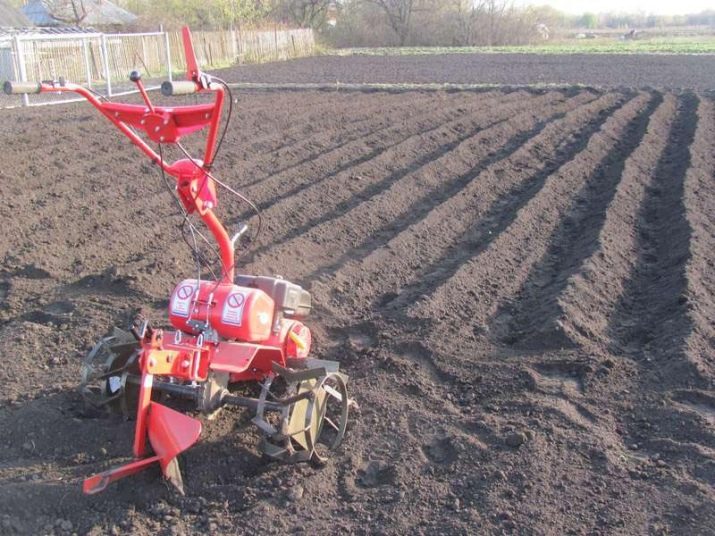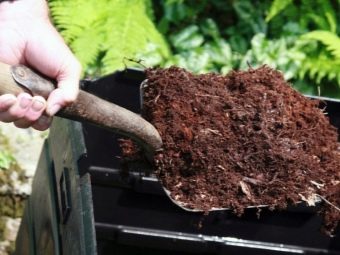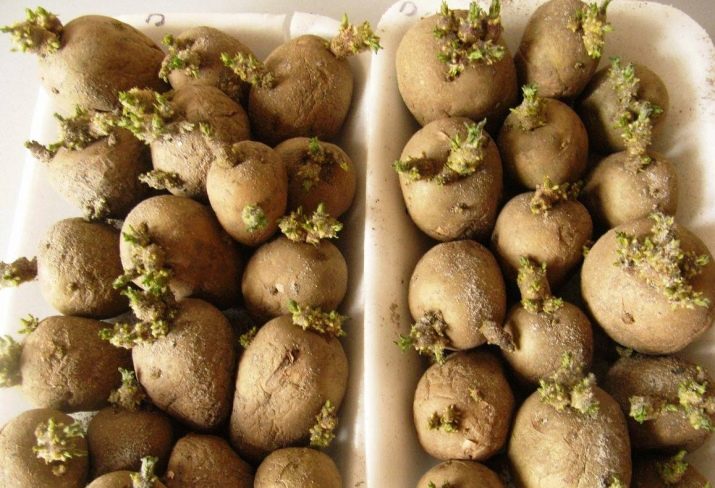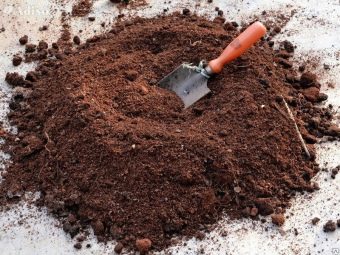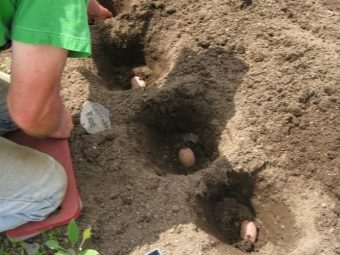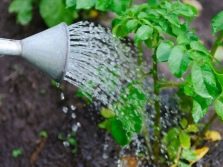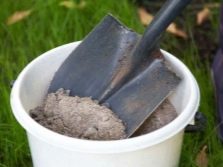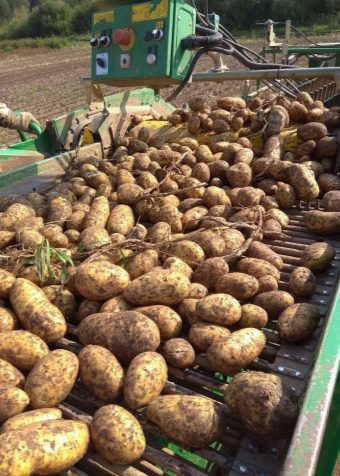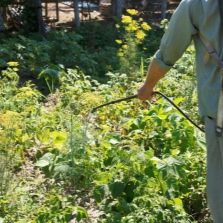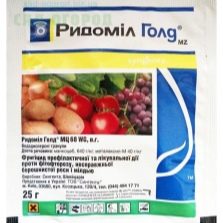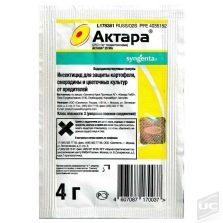Potatoes "Queen Anne": features and cultivation
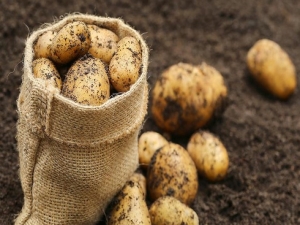
Potatoes universal variety "Queen Anna" was bred in Germany recently, but has already won the hearts of Russian gardeners.Among its advantages are the bountiful harvest, excellent taste, innate immunity to most diseases, and relatively early ripening. It is also worth adding to the list of advantages the absence of serious requirements for the state of the soil and climatic conditions, and it becomes clear what this potato is good for.
Variety description
The potato “Queen Anne” was officially recognized in Russia in 2015. The variety is middle-ripening - in less than three months after the first shoots appear, you can already begin to harvest the fruits.
The characteristic of this variety contains a lot of useful information for gardeners. Bushes are small and low, slightly bending down or straight with medium-sized green leaves and resistant stems. Leaves pubescent. Their structure contributes to the fact that the liquid slowly evaporates from the soil, and that, in turn, is not exposed to the rays of the sun. Floral corollas are quite large and white.
Fruits of traditional oval shape, slightly elongated, with small eyes. From one plant you can get from six to sixteen potatoes. The flesh is cream-colored, and the smooth skin is yellow. The slightly sweet taste of the fruit receives only the highest marks. Weight ranges from 80 to 130 grams, and length reaches 10 centimeters. The starch content of tubers is approximately 13-14%.
This indicator depends on climatic conditions: if the weather is dry and hot, then the starch will be more than in cloudy and rainy.
"Queen Anna" is able to grow in different climates and on different soils. It successfully confronts diseases such as cancer, wrinkled mosaic, leaf curling, and others. In addition, the plant is extremely rarely prone to late blight on the leaves and tubers. Harvest, on average, ranges from 1 to 3 kilograms per square meter, and the maximum number reaches 5 kilograms. Total, with a hectare of beds you can get about 450 centners of the product.
Such potatoes are used in any form: fried, boiled, crushed, and others. It is very easy to wash and clean. Vegetable is not boiled soft and does not change color during cooking, which greatly simplifies the cooking process. Queen Anne perfectly transports storage and can be kept in proper conditions until the spring, without losing its product characteristics. That is why this variety is often offered for sale.
Reviews say that the fruits grow delicious, attractive and similar in size and shape. A bountiful harvest can be harvested quite early, sometimes even six weeks after planting, and caring for the potato itself does not cause any particular difficulties. The consistency of the fruit is not sticky and weakly granular, and they are large, but not too much. Another advantage is the fact that vegetables during storage are not subjected to attacks of mold, rot, are not covered with black spots.
Advantages and disadvantages
The benefits include the following indicators.
- The main advantages of the variety "Queen Anne" is its good ability to germinate.
- Tubers are quickly and simultaneously formed, and then grow the same size and attractive shape. It is also worth noting that there are no overly small fruits, even when the crop is harvested for the first time in a season.
- The small size of the eyes makes it easy to peel potatoes, and then use it in any dishes.
- Queen Anne is not injured during the collection, hassle-free transportation and is popular with customers.
- Pleases sellers and keeping quality - the crop can be sold throughout the winter and even spring months.
- Of course, the pluses include taste, as well as the content of nutrients and trace elements.
- The plant is unpretentious and not afraid of many common diseases.
Such a potato has almost no flaws, the only thing that can be noted is the demands on regular and abundant watering.
Landing
Before you plant a variety of "Queen Anna", you need to choose the right place for the garden. It is important to observe the following conditions:
- sufficient illumination;
- lack of opportunities for moisture stagnation;
- wind gust protection available.
It is impossible for this place to grow solanaceous, including sweet peppers and tomatoes, it is better to give preference to the beds where pumpkins, onions or cruciferous crops were present. It will be possible to return to the former potato sites only in three years.
What type of soil will be chosen is not important in principle. However, it is recommended to choose a soil saturated with nutrients, with neutral acidity, moderately loose and air permeable. If the soil is poor, then it can be fertilized with suitable substances, and acidic can be fertilized.
Since autumn, the selected area has been dug up, freed from weeds along with roots, and fertilized with ash and humus or with mineral solutions containing superphosphate and potassium nitrate. In the spring, just before planting, the soil will have to be re-dig and level, add nitrogen fertilizers, and then dig holes and form rows. The grooves will be well sprayed with a bright pink color of potassium permanganate. In addition, there is a recommendation to place potato "plantations" from north to south. So the bushes will be able to warm up evenly and get enough sunlight.
As the "seeds" are used very green fruits, which can not be eaten, as inside is in large quantities is quite dangerous for the human body substance solanine. The tubers themselves are best pre-germinate. Non-rotten and intact potatoes of the same medium size are selected. It is also not necessary to choose tubers with thin stretched sprouts. Superficial eyes from them is not worth cutting. The number of tubers used must match the number of planned bushes.
The selected samples are laid out in a room where a warm, comfortable temperature and sufficient illumination are maintained. While sprouts are expected, warming up potatoes are processed from insects, and, if desired, with growth stimulants. You can plant germinated tubers by holding them in the sun. So in the peel begins to produce solanine, in moderate quantities able to increase the resistance of the vegetable to disease and temperature changes.
Planting ready-made potatoes on the beds is possible only when the soil reaches the required temperature (16-18 degrees of heat in the upper layer, 10 degrees C - at the depth), and also gets dried. In addition, all periods of frost should end. This period depends on the climatic features of the region, but usually lasts from late April to early May. Too early planting will lead to the fact that seedlings do not appear at all, or else they appear too late. Too late planting is also bad for the tops and the fruits themselves.
When placing future bushes on the beds, care must be taken to ensure that there is a comfortable distance between them, usually 40 centimeters. The soil must first be slightly irrigated with warm water, but not too much - otherwise it is possible to provoke the process of decay due to lack of oxygen. Pre beds can also be held under plastic wrap to increase the temperature.
Only one whole potato is sent to each well for 10 centimeters (it’s better not to use the halves) - only in this case, the future fruits will have enough available food for successful growth. It is possible to deepen the potato in the furrows, but some gardeners choose a method of planting in a checkerboard pattern. Having finished planting and digging holes in order to prevent the potatoes from winding up, a layer of peat from 2 to 3 centimeters should be created on top - that is, to produce mulching.
Care
It is quite easy to care for “Queen Anna” - the recommendations are pretty standard.Potatoes should be watered regularly, and the amount of moisture used should increase during the period of tying tubers, as well as drought. Watering should take place at least once in 7 days. Best of all this variety refers to the spraying of moisture. Weeds should also be removed regularly and the soil should be loosened - this procedure ensures the enrichment of the roots with oxygen. It is important to conduct and earthing up to speed up and improve the tying of tubers. This action will save the roots from drying out, as well as sunburn.
Top dressing is usually carried out three times: when the stems grow, on the eve of the appearance of flowers and at the stage of active flowering. Both mineral and organic are good. The first are drugs that contain superphosphate and potassium nitrate, and the second is manure, litter, and ash.
One square meter of bed requires 10 kilograms of rotted or diluted manure, or 1 liter of ash.
Of course, it is important to periodically inspect the bushes for diseases or attacks of pests. Harvesting potatoes begins as soon as the tubers become the size and weight of Queen Anne. It makes no sense to leave them on the beds for a longer period - the quantity and quality will not change. Usually at this moment the bush itself dries out and becomes yellow. Experienced gardeners are advised to first mow the tops, and after digging potatoes. This trick allows you to tighten the rind of the fruit and, thereby, increase its shelf life.
If it is expected to freeze, then on the night of the beds you need to wrap with plastic wrap or smoke them. Storage of potato varieties "Queen Anne" requires certain conditions. The temperature should be low, but still above zero, and the humidity should vary from 60% to 70%. Usually a dark and dry room is chosen for this purpose.
Diseases and pests
One of the advantages of the Queen Anne variety is its innate ability to withstand many of the diseases characteristic of the nightshade. However, prevention is always important - quality soil care, treatment of damaged bushes and spraying with drugs such as Ridomil Gold. Processing of potatoes with fungicides capable of protecting the plant from pests is also considered mandatory. It should be borne in mind that chemical treatment is possible only at least a couple of weeks before the crop ripens.
Disinfection with Aktara, Outright and similar solutions will help to save potatoes from a bear and potato moth, and timely removal of weeds and loosening the soil will help prevent their occurrence.
Review of potato varieties "Queen Anna", see the following video.

